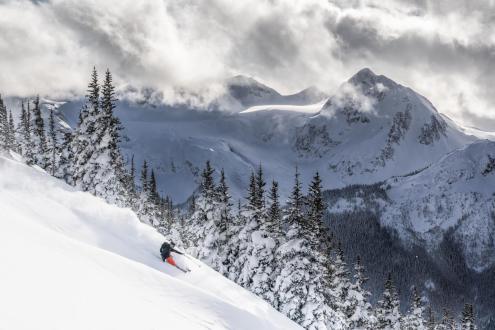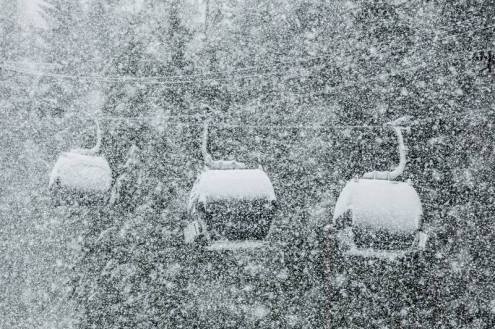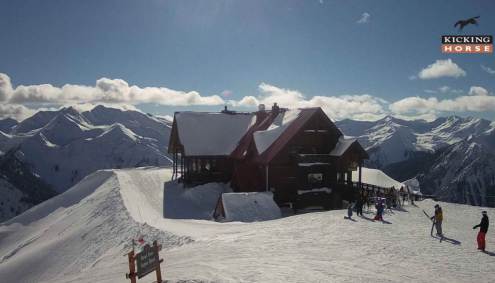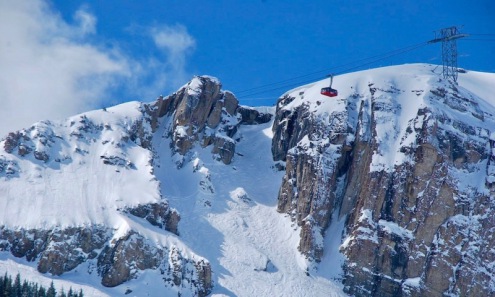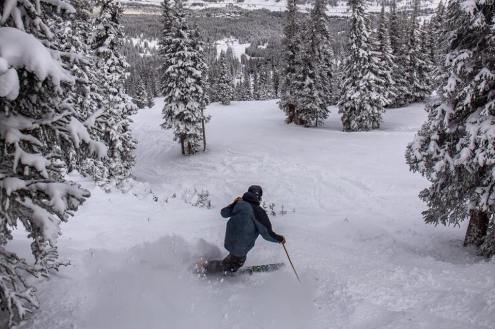Who got the most snow in North America in 2018-19?
Guest feature by Tony Crocker, 16 July 2019
2018-19 was an above average snowfall season in North America's ski areas, at 106% of normal. Qualitatively it was excellent because early snowfall was adequate overall, meaning that there were no deficient regions over the holiday season.
Most of the excess snowfall came during a huge February in California, Utah and the Southwest. As a result, US skier visits were the highest since the record 2010-11 season.
Pacific North-west
The Pacific Northwest had a dry November, but in mid-December it dumped 3+ metres at Whistler and Mt. Baker and about half that further south, ensuring a strong holiday season.
Whistler was again favored during early January with 1.5m, but for the rest of the season snowfall was consistently heavier further south. February was well above average but March and April saw less than half their average snowfall, so overall the region finished at 90% of normal.
Mt. Baker led the region with 13.4m (81%) while Mt. Bachelor had 9.8m (101%), Crystal had 11.0m (105%) and Whistler had 9.6m (90%). Alyeska saw excessive rain at lower levels leading to a record low of 3.2m of snow (26%) mid-mountain, despite it getting 14.5m (89%) at the top of its highest lift.
Interior Western Canada
Interior Western Canada had average November snowfall and saw enough of the December Northwest storms to yield an excellent holiday season. Snowfall in the first half of January was average, but the rest of the season was increasingly dry, with only the areas near the border seeing much of the February snow pounding the western US.
March and April had far less than half of their average snowfall, resulting in an 81% of normal season overall. Sun Peaks (3.0m, 58%) and Sunshine Village (4.0m, 61%) had record low snowfall, while Fernie had 7.1m (74%). Revelstoke led the region's ski areas with 8.7m (93%), though the snowier snowcat and heliski locations in the Selkirks and Monashees received 10+ metres of snow.
US Northern Rockies
The U.S. Northern Rockies had 103% of normal snowfall overall, with most areas close to average in November, December and January. February storms dumped 3-4m in Idaho and Wyoming, but only half as much in the interior Northwest near the Canadian border. March and April had less than half normal snow.
Grand Targhee led the region with 12.0m (102%), while Jackson Hole had 10.4m (111%), Big Sky 9.1m (125%) and Sun Valley 6.1m (122%). Interior Northwest areas like Whitefish (7.2m, 84%) and Schweitzer (6.1m, 85%) did not fare as well as the areas further south.
The Northeast
Although the Northeast only had 102% of normal snowfall overall, qualitatively 2018-19 was a far above average season. Northern New England enjoyed a near record November with almost 2m of snow and no rain or thaw.
Several rain events in December degraded surfaces but most of the early snowpack remained. January was another strong month averaging 2+ metres of snowfall, with continuing excellent conditions a week into February. Conditions deteriorated in mid-February with rain and freeze, but good skiing was restored from late February to mid-March. Spring saw a lot of rain but the good winter coverage lasted long enough for Killington to stay open until 2 June.
Smuggler's Notch led the region with 9.5m (115%), while Jay Peak had 9.1m (111%), Sugarloaf had 5.9m (133%) and Le Massif had 6.4m (107%). Snowfall was below average further south at Killington (5.6m, 90%) and Stratton (3.3m, 69%).
Colorado (and New Mexico)
Colorado's Front Range/I-70 resorts saw over a metre of snow in early November, resulting in an excellent early season leading into the holidays. Further south, early season snowfall was below average, so some advanced terrain did not open until January, which overall saw average snowfall.
February storms just grazed the northern 2/3 of Colorado but dumped 2-3 metres in the Southwest. March was spectacular, with all areas getting 2-3 metres of snow. After an average April, a metre of May snowfall allowed A-Basin (8.4 meters, 105%) to stay open at weekends until 4 July.
The Front Range was overall 107% of normal, led by Breckenridge (10.9m, 122%) while Steamboat (9.3m, 99%) and Vail (9.3m, 104%) were close to average. The Southwest was overall 115% of normal, led by Wolf Creek (12.9m, 131%). Aspen Snowmass had 8.7m (117%) and Telluride 8.8m (126%), while across the state line in New Mexico, Taos had 6.3m (93%).
Utah
Utah's early season was slightly below average but a metre of snow in late November established a base for good holiday skiing in the Cottonwood areas. From mid-January onwards, Utah's season was outstanding, with up to 2m in late January, 3+ metres in February and 2m during the first half of March. Late March and April snowfall was average, with the season overall at 115% of normal.
Brighton led the state with 15.7m (122%), while Alta had 14.9m (114%), Park City had 9.1m (124%) and Snowbasin had 10.7m (133%). Snowbird (13.9m, 110%) had a metre of May snowfall and opened at weekends until 4 July.
California
California snowfall was slightly below average through the holiday season with most of the snow coming in late November and early December. Full operation was attained when 1+ meter of snow fell during the first week of January, followed by a further 1.5m two weeks later
February set records for all Sierra areas with at least 5m of snow and 7+ metres at the highest elevations. Snowfall was average in March and below average in April, with the Sierra season being 137% of normal overall.
Heavenly’s upper site got 12.0m (122%) while Kirkwood saw 15.0m (128%). Squaw Valley's upper site (18.3m, 155%) led North America in snowfall and will open at weekends into July. Mammoth saw 12.5m (140%) and will open daily until 28 July 2019.
Tony Crocker is an award-winning snow-sports journalist
and founder of www.bestsnow.net - the definitive guide to weather
and snowfall patterns in North American Ski resorts.
Read more about him here
See who got the most snow in North America in other years



